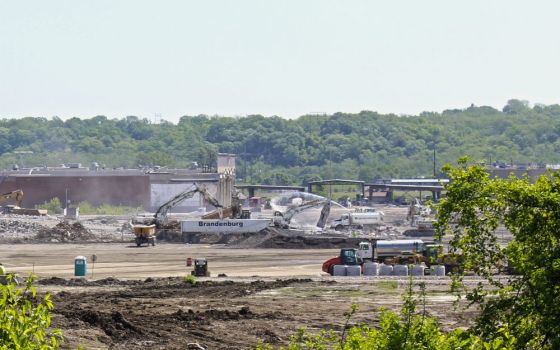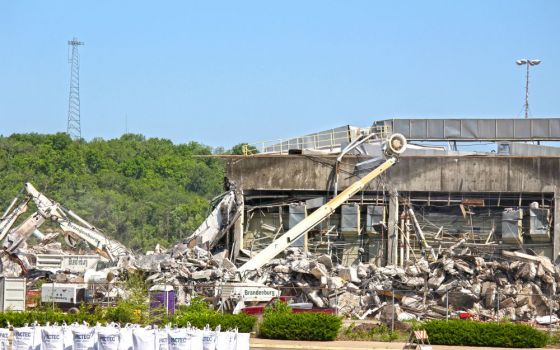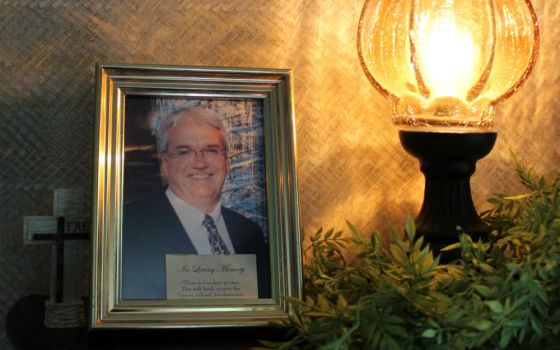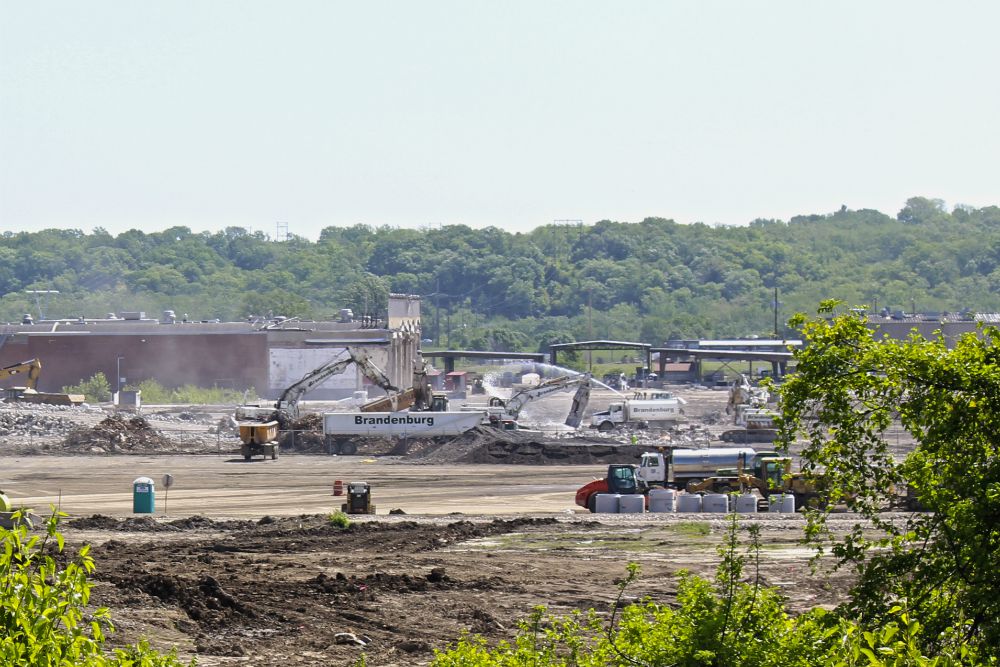
Dust rising from demolition work can be seen at the old Kansas City Plant site in south Kansas City, Missouri, pictured May 16, 2019. (NCR photo/Toni-Ann Ortiz)
Editor's note: As the government invests in the modernization of the U.S. nuclear arsenal, while weakening environmental regulations and federal laws protecting worker safety, National Catholic Reporter looks at the toxic legacy of one shuttered weapons plant in Kansas City, Missouri.
In a three-part series about the Kansas City Plant on Bannister Road and its successor 8 miles south, NCR reviews hundreds of pages of government reports and environmental summaries, and interviews more than two dozen sources, including five plant workers and their families, three former federal employees who worked nearby, nuclear industry and government officials, health experts, business sources, state environmental regulators and a former city councilman.
The exodus was brisk. After decades of housing a Cold War-era nuclear weapons plant, as well as offices for various government agencies, the Bannister Federal Complex in Kansas City, Missouri, lost most of its tenants in a couple of years. Eager to make nuclear weapons production "leaner and greener," the National Nuclear Security Administration relocated its Kansas City Plant to a new site 8 miles south in 2014. A year later, the federal offices moved downtown.

The migration left 230 acres of the 300-acre site available for use, but the property was highly contaminated. In December 2017, Kevin Breslin, a private developer, acquired its deed free of charge and is progressing in his plans to redevelop the former federal complex into an industrial park.
For many in Kansas City, the acquisition represented an innovative effort to redeem a dangerous brownfield. Sick workers and their advocates wondered if the Bannister site could ever really be cleaned as more revelations surfaced about the Kansas City Plant's toxic legacy.
It was an unusual real estate transaction, the federal government deeding acreage that once held a nuclear weapons plant to a private developer and providing funds for its cleanup. Seventy years of manufacturing airplane engines and electrical components for nuclear bombs had left their mark. The Kansas City Plant buildings contained numerous industrial pollutants including beryllium, a hazardous metal. "Hot spots" of residual radioactivity were in the soil and some factory shops. Toxins had migrated to nearby offices leased by the General Services Administration (GSA), which with the Department of Energy (DOE) co-owned the Bannister complex.
Decades of storing hazardous waste on the property had also polluted the soil, groundwater and an adjacent river.
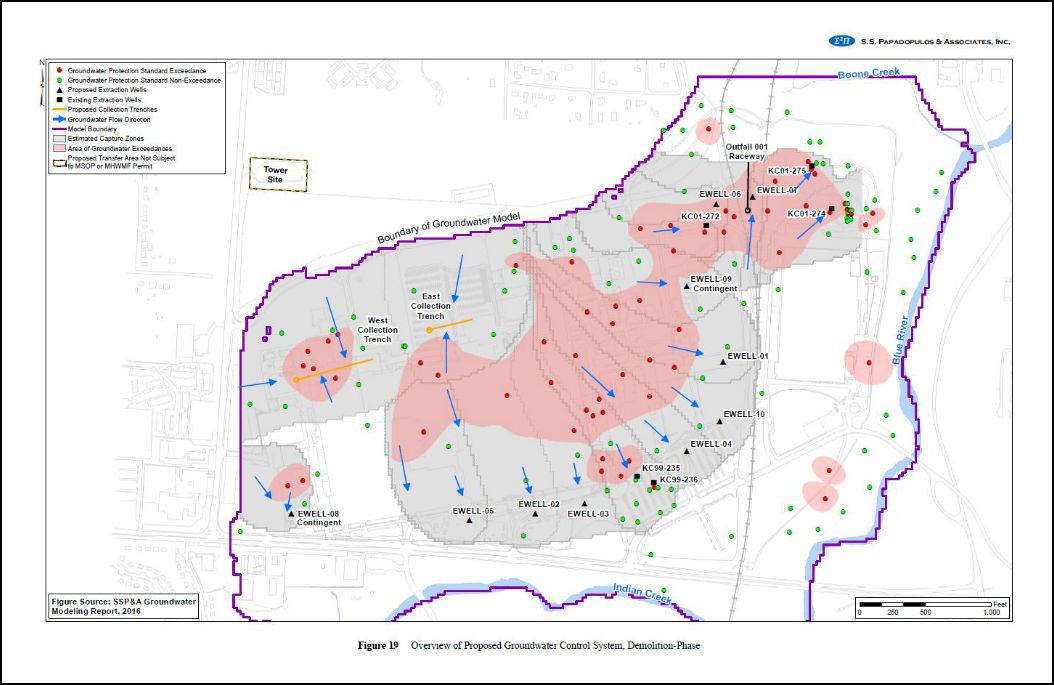
Map of overview of proposed groundwater control during demolition from the "Corrective Measures Report, Bannister Federal Complex, Kansas City, MO, Draft Final, April 2017" shows where protective standards are exceeded.
Contamination at Bannister was so extensive the Environmental Protection Agency (EPA) had in 1987 considered placing the property on the Superfund National Priorities List, a designation given to sites with known or threatened releases of hazardous substances. Initial redevelopment plans included redeeming the site for residential use. But that idea required a more rigorous level of cleanup and was scrapped as too expensive.
"I agree with that decision," said Mark Hogan, former manager of hazardous waste at the Missouri Department of Natural Resources. Hogan had worried about the prospects of placing houses atop polluted groundwater. "[Now] nobody is going to live above this contamination," he said.
Despite the mess, Breslin saw a property with possibilities. He established Bannister Transformation & Development LLC (BTD) to acquire the federal site and build a park with 2.5 million square feet for light industry and distribution facilities. He projects the revamp will bring in 1,500 private-sector jobs and that the property will be fully ready for use by 2022. (Documents like the "Corrective Measures Report" by S.S. Papadopulos & Associates, Inc., which excerpted in map graphics in this article above and below, can be seen on the BTD site.)
"Restoring so-called 'brownfield sites' such as the former BFC [Bannister Federal Complex] property represents a decades-long trend in progressive urban policy across America," Breslin wrote in an email to NCR, adding that, after safe and successful cleanups, these sites increase the tax base and spur new jobs.
It was a double win for South Kansas City and Breslin. As a federally owned property, Bannister had remained tax exempt for nearly 70 years. Property tax assessors for Jackson County determined the federal complex had "no value" prior to transfer due to its aging structures and known environmental conditions. Once remediated, the leased industrial site could bring in $10 million a year, according to one research estimate.
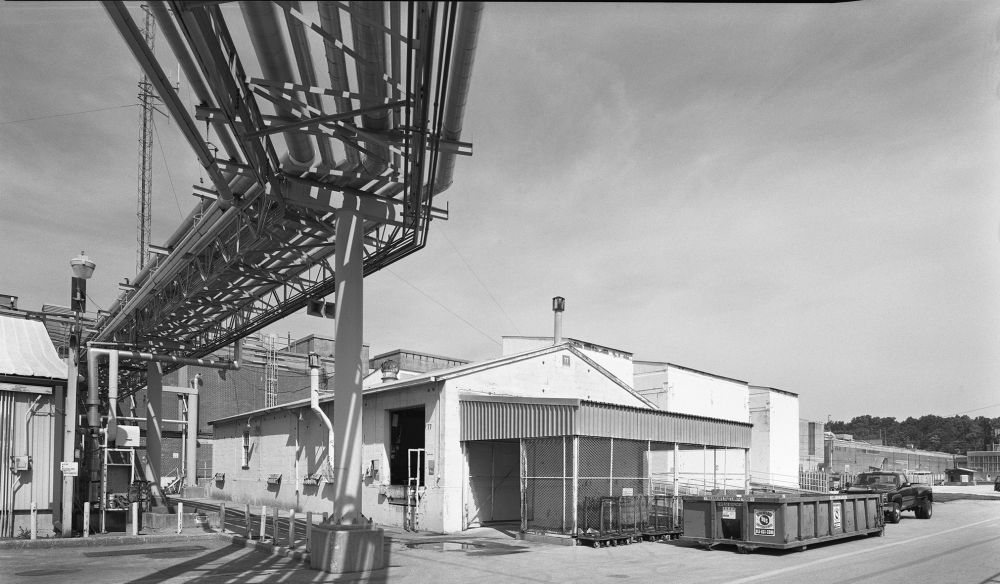
Fuel lines seen at the old Kansas City Plant in 2013 (Historic American Engineering Record, U.S. Department of the Interior/Richard Welnowski)
"This is a great step forward for Kansas City," said Mayor Sly James, after the federal government confirmed the first phase of the transfer back in October 2017. "What this represents for the quality of life is jobs, economic growth and activity — as well as a transformational project in the heart of South Kansas City."
Former City Councilman John Sharp was especially relieved. For 16 years, Sharp represented the district that includes the Bannister complex. Public concern about toxins at the Kansas City Plant had been nonexistent in the 1980s and only came to the fore during his later terms from 2007 to 2015, he said. Sharp had worried that listing Bannister as a Superfund site would have meant years of living with an abandoned toxic facility in the neighborhood, bordered by a river and a creek, while awaiting government funds for a cleanup.
"It's like a time bomb sitting over there, until they clean it up," Sharp said. "It was just wrong how the workers were treated. These were patriotic people doing something that they thought was essential to protecting the country."
The private-public collaboration so pleased EPA they honored all the companies and agencies involved in the transfer, including Breslin's BTD and the National Nuclear Security Agency.
Advertisement
Not everyone greeted news of the Bannister Federal Complex's redemption with enthusiasm. Former Kansas City Plant employees seeking compensation worried the proposed remediation would destroy evidence for their claims of worksite contamination. Wayne Knox thought the place was "a crime scene" that shouldn't be tampered with prior to an independent investigation. A retired occupational health physicist with years of experience working at DOE sites, Knox worried about the thoroughness and safety of any remediation effort.
In October 2017, sick workers and family members of deceased workers wrote to then Missouri Gov. Eric Greitens requesting an independent investigator be allowed to take samples at the Bannister complex to aid their claims for compensation.
Ann Suellentrop, a local nurse and past president of the Alliance for Nuclear Accountability, wrote the letter to the governor, whose approval was required for the transfer of the federal property. The letter also spoke on behalf of residents living near the complex. The signers questioned why the proposed cleanup was not done to a more rigorous level, residential rather than industrial. Aware of the hazards of beryllium dust, they asked that a tent be placed over the area during demolition to contain air pollutants. They worried about the "huge underground plume of deadly volatile organic compounds and PCBs [polychlorinated biphenyls]" flowing into the Blue River and Indian Creek when the buildings and parking lots were demolished. They also wanted the governor to ensure that full funding for the cleanup was guaranteed and that site monitoring would continue "into perpetuity, as long as the waste is there threatening the workers, the public's health, and the environment."
Greitens never replied to the letter, Suellentrop said. He resigned in June 2018, about 18 months after taking office.
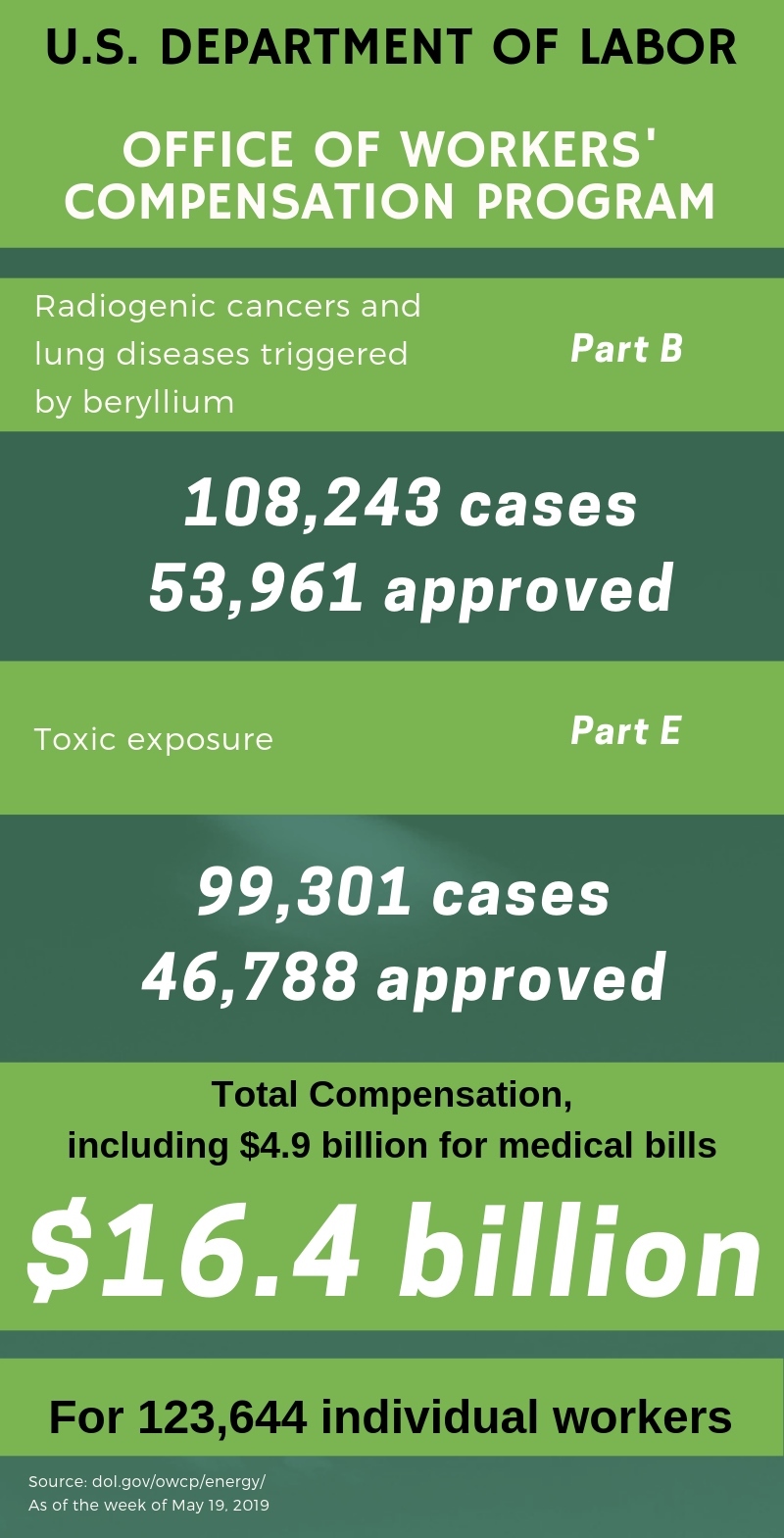
The Energy Employees Occupational Illness Compensation Program Act was enacted in October 2000. Part B, effective on July 31, 2001, compensates for the diagnoses of a radiogenic cancer, chronic beryllium disease, beryllium sensitivity, or chronic silicosis, as a result of exposure to radiation, beryllium, or silica while employed at covered facilities. Part E, enacted October 28, 2004, compensates for any occupational illnesses that are causally linked to toxic exposures in the DOE or mining work environment. (NCR graphic/Toni-Ann Ortiz, Tracy Abeln)
Industrial strength oversight
At the height of the Cold War, the U.S. had nearly 350 nuclear weapons facilities in operation. Upon closure, many became hazardous brownfields that proved costly to redeem. In Colorado, the federal government transformed Rocky Flats, an enormous plant outside Denver that produced plutonium triggers for nuclear weapons, into a wildlife reserve where bison now roam. Miamisburg, Ohio, created a community improvement corporation to redevelop Mound Laboratories, a top-secret plant that produced radioactive material, into a business and scientific technology park. Remediation of its 305-acre property cost U.S. taxpayers $1.1 billion. The government paid an additional $181 million to 1,678 former Mound employees and their families for work-related illnesses and deaths.
Federal law prohibits the transfer of environmentally contaminated government property without meeting regulatory oversight requirements. And there were many for the Bannister complex. The DOE had to provide a detailed summary of the property's history of use and its contaminants.
Working on behalf of the potential new owner was CenterPoint Properties, an Illinois-based company that specializes in industrial real estate development. CenterPoint contracted S.S. Papadopulos, an environmental consulting company, to probe the soil, test the groundwater and scan the surfaces of the manufacturing spaces — walls, pillars, drains, air ducts and rooftops. The DOE and the EPA also contracted specialists who checked and rechecked factory shops for remnants of radioactive material.
The federal government was not the most forthcoming landlord when it came to divulging the pollutants on the property. The pre-transfer surveys detected areas of contamination that had not been identified in the DOE's summary of conditions. These new discoveries generated hundreds of pages of reports between CenterPoint and the DOE, in an attempt to fully identify the property's hazards. Overseeing the back and forth was the Missouri Department of Natural Resources, the lead environmental, regulatory agency for the Bannister complex, with assistance from the EPA.
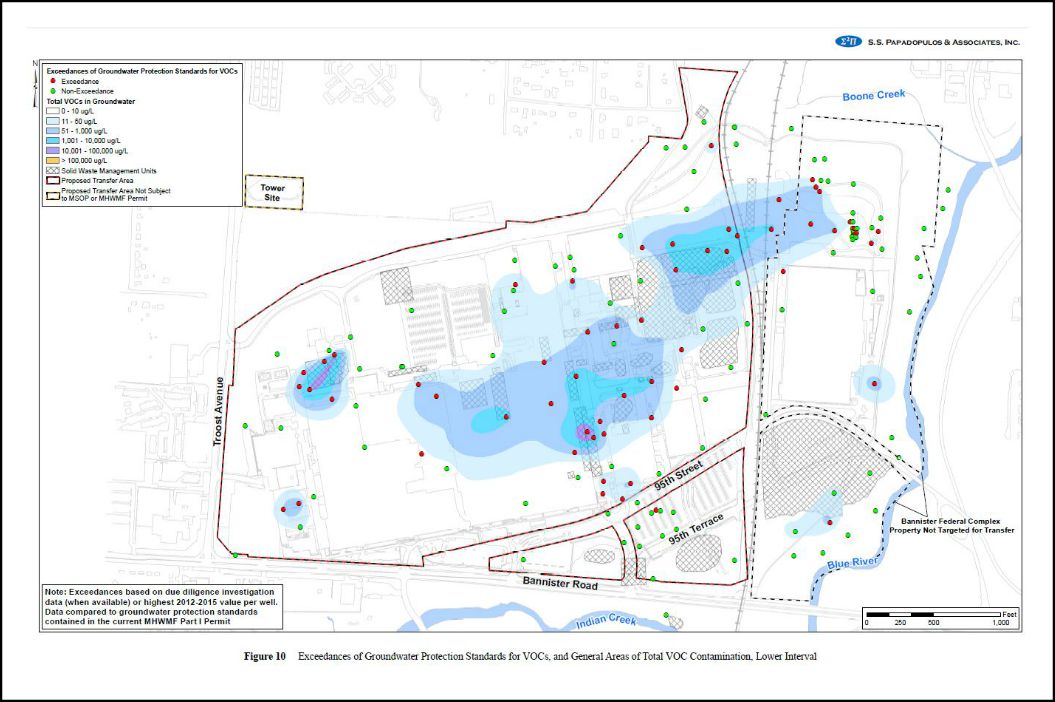
Graphic from "Corrective Measures Report, Bannister Federal Complex, Kansas City, MO, Draft Final, April 2017" shows where volatile organic compounds, or VOCs exceed groundwater protection standards at the Kansas City Plant site. (S.S. Papadopulos & Associates, Inc.)
The surveys' findings gave credence to workers' fears of jobsite contamination. While most of the hazards in the ground were industrial pollutants such as PCBs, fume-emitting solvents, and hexavalent chromium, a toxin that can cause lung cancer, soil tests also revealed small amounts of radiological contamination. There were traces of depleted uranium outside one building and elevated readings for uranium in one area and for Thorium 232 in all of the samples collected. At a May 2017 public meeting about the cleanup, Harvey Cohen, a hydrogeologist with S.S. Papadopulos, said as much as 40,000 cubic yards of contaminated dirt, enough to fill 600 rail cars, would need to be removed.
The surveyors also detected "hotspots" of radioactivity on building surfaces, in floor drains, and in an air duct that was part of the HVAC system of the Kansas City Plant's Main Manufacturing Building. Former Bannister employees claiming worksite-related illnesses had often wondered if one source of their exposure was the shared ventilation system between the plant's manufacturing spaces and government offices.
The property's extensive remediation is underway. A recent story on the massive overhaul by Kansas City's Channel 41 Action News showed heavily sealed rail cars transporting the stuff to a hazardous waste landfill in Roachdale, Indiana. One million cubic yards of new soil will be brought in to regrade the property, the television station reported. To address the plumes of contaminated groundwater, Breslin is building trenches, barrier walls and extraction wells reaching to bedrock that will suck out the pollutants. It's a drastic makeover for a boggy acreage where people once tried to grow corn.
Persistent pollutants
There are many reassuring aspects to Bannister's cleanup. Hogan praised Breslin as a property owner who exceeds the requirement for transparency. Breslin retained consultants who were part of the pre-transfer investigation of the property. Hydrogeologist Cohen, environmental leader for the project, meets weekly with state and federal regulators. Every truck leaving the federal complex is scanned for radioactivity. The cleanup is ahead of schedule, Breslin said, because his team had "not encountered unexpected conditions or significant impediments." to the cleanup.
But cleaning up a property that for decades manufactured components for nuclear weapons is not like mopping up your kitchen floor. Here the "dirt" is persistent and not easily removed. Over the past 70 years, the complex has undergone numerous cleanups — two following significant spills of PCBs, a decommissioning and decontamination in the 1970s at the conclusion of plant operations involving radioactive materials, and another one in the late 1980s.
"A big part of the cleanup strategy for shuttered weapons facilities is containing and relocating the environmental hazards. Figuring out where to store the stuff has been very hard for our society."
—Matthew McKinzie, senior scientist, Natural Resource Defense Council
Yet none of these efforts thoroughly eradicated the contaminants of concern. PCBs are still being detected in the tissue of fish swimming Indian Creek nearly 50 years after a burst pipe released 900 gallons of the pollutant into the waterway. Hot spots of radioactivity showed up in some of the manufacturing areas decades after a major decontamination and decommissioning. Less than 10 years after Honeywell changed its hygiene protocol for beryllium, a DOE report raised concerns that an unidentified source of beryllium exposure was continuing to sicken workers at Kansas City Plant and other plants.
"A big part of the cleanup strategy for shuttered weapons facilities is containing and relocating the environmental hazards," said Matthew McKinzie, a senior scientist at the Natural Resource Defense Council who has a doctorate in experimental nuclear physics. "Once contaminants are released into the environment, their behavior is complex. They can move downstream, become windblown."
"Figuring out where to store the stuff has been very hard for our society," he added.
Congress allocated $250 million for the demolition and remediation of the Kansas City Plant. That amount includes $11 million in contingency funds, should BTD, Breslin's company, encounter any unanticipated contamination on the site. Breslin said he was highly confident the allotted funds would cover the cost of an environmental cleanup in accordance with the standards adopted under the public-private partnership. In the "unlikely event that additional resources were needed," he noted in an email to NCR, U.S. environmental law obligates the federal government "to assure the public and the State of Missouri that the property shall be cleaned up so as to protect human health and environment."
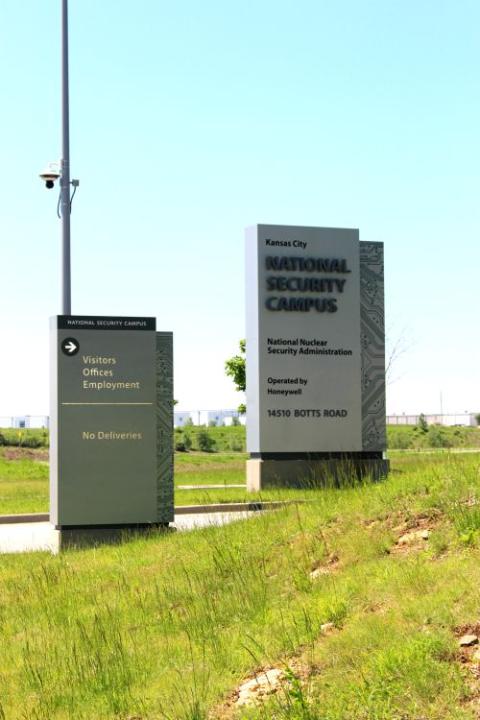
Entrance to Kansas City National Security Campus, 14520 Botts Rd., Kansas City, Missouri (NCR photo/Toni-Ann Ortiz)
Business is booming at the new Kansas City Plant, or Kansas City National Security Campus, as it is now called, on Botts Road in South Kansas City. The Trump administration's 2020 budget request for the operation is close to $1 billion — an almost 50% increase over 2018 spending. To accommodate the push for production, the plant is rapidly increasing its workforce and plans to expand its facility by one third in the next five years. The polluting Cold War plant of yesteryear may have a new locale with more eco-friendly facilities, but its mission remains the same. DOE spokeswoman Gayle Fisher said that processes involving radioactive material and radiation-generating devices are comparable to those used in commercial manufacturing and laboratories and do not generate contamination that could be "inadvertently inhaled, ingested, or absorbed." In an email to NCR, Fisher described an operation at the plant requiring "small pieces of depleted uranium" and reported that beryllium is used in "limited and highly regulated areas."
"We take our responsibility to protect the health and safety of our employees and the surrounding community very seriously," said a spokeswoman for Honeywell, the government contractor operating the Kansas City Plant. All employees are required to complete an "annual Health, Safety and Environment training," Tanya Snyder wrote in an email to NCR. Workers handling beryllium receive additional instruction and are enrolled in a DOE beryllium surveillance program. Snyder said the plant "maintains a well-developed set of environmental practices and spill/release response plans" for handling an emergency and would "work closely with the appropriate regulatory agency to ensure appropriate action is taken."
State Natural Resources has issued several permits to the new site concerning air pollution control and regulation of storm water. The department is still in discussion with the DOE over an agreement that would grant Missouri regulators independent oversight of responses to environmental accidents.
Does this mean a history of local contamination won't repeat itself at the new site?
Compared to the Cold War plant, the industrial processes will probably be cleaner the second time, said Jack Cohen-Joppa, editor of The Nuclear Resister and longtime monitor of the nuclear arms industry. "However, that doesn't consider … the product or the reality that nuclear waste needs to be isolated in the environment forever." The Trump administration is trying to roll back radiation protection standards, Cohen-Joppa said, "so, if 'greener' means you are having to meet a less rigorous standard, then we are comparing apples to oranges."
Even with good hygiene protocol and scrupulous monitoring, the worksite environment in the nuclear weapons industry can become quickly hazardous. In the rush of production, worker protection gets short shrift. A plant inherits "hot" equipment from another facility. A supplier fails to thoroughly seal packages containing radioactive substance. Beryllium dust settles on surfaces too high to clean then seeps through vents.
McKinzie, the nuclear physicist, thinks the industry's hazards are inherent. "The design and development of nuclear weapons involves dangerous material, and every country that has built them harms its own people and environment."
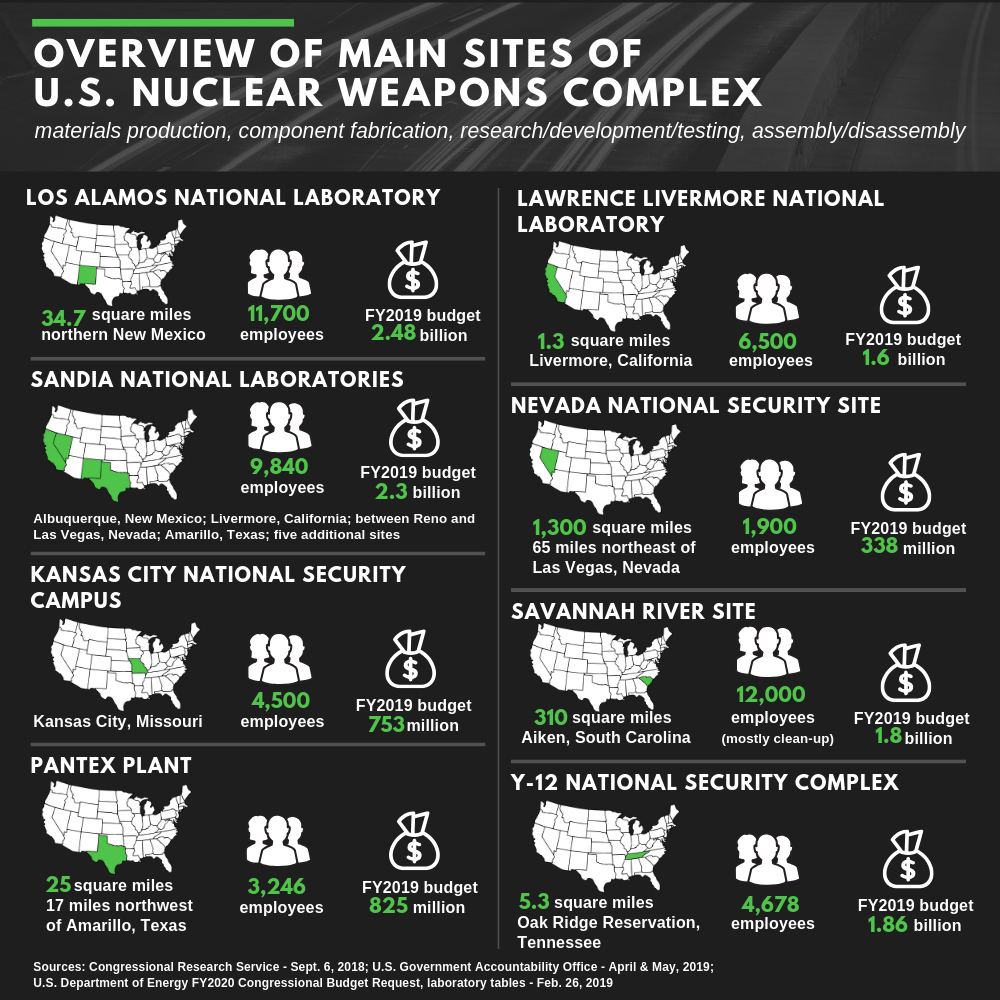
The Kansas City National Security Complex has requested a FY2020 budget of $995.6 million. (NCR graphic/Toni-Ann Ortiz and Tracy Abeln)
The ghosts of the old Kansas City Plant continue to haunt the new one. Every Memorial Day for the past several years, peace activists and worker advocates hold a demonstration at the new site that includes a "die in." After reading the names of former Bannister employees who died allegedly from worksite-related illnesses, the participants lie on the ground, as if dead. This year, Debbie Penniston plans to read out her husband's name and make a speech.
In 2008, Bob Penniston, 50, died of brain cancer which she attributes to his 27 years of working at the Kansas City Plant. Her anger has only increased with the passing of time, she said, "not because he died, but because they didn't let [the employees] know that there is something under that land and that, if they wanted to stay, it's at their own risk." Years ago, she worried her participation in a Kansas City Plant protest would have angered Bob. She is more confident in her conviction now and even thinks he would approve.
"He thought [the old plant] was a good place to work," Debbie said. "No, it wasn't."
[Claire Schaeffer-Duffy, a freelance writer, lives and works at the Sts. Francis and Therese Catholic Worker Community in Worcester, Massachusetts. She and her husband, Scott, co-founded the community in 1987. She has been contributing to National Catholic Reporter since 1999.]





